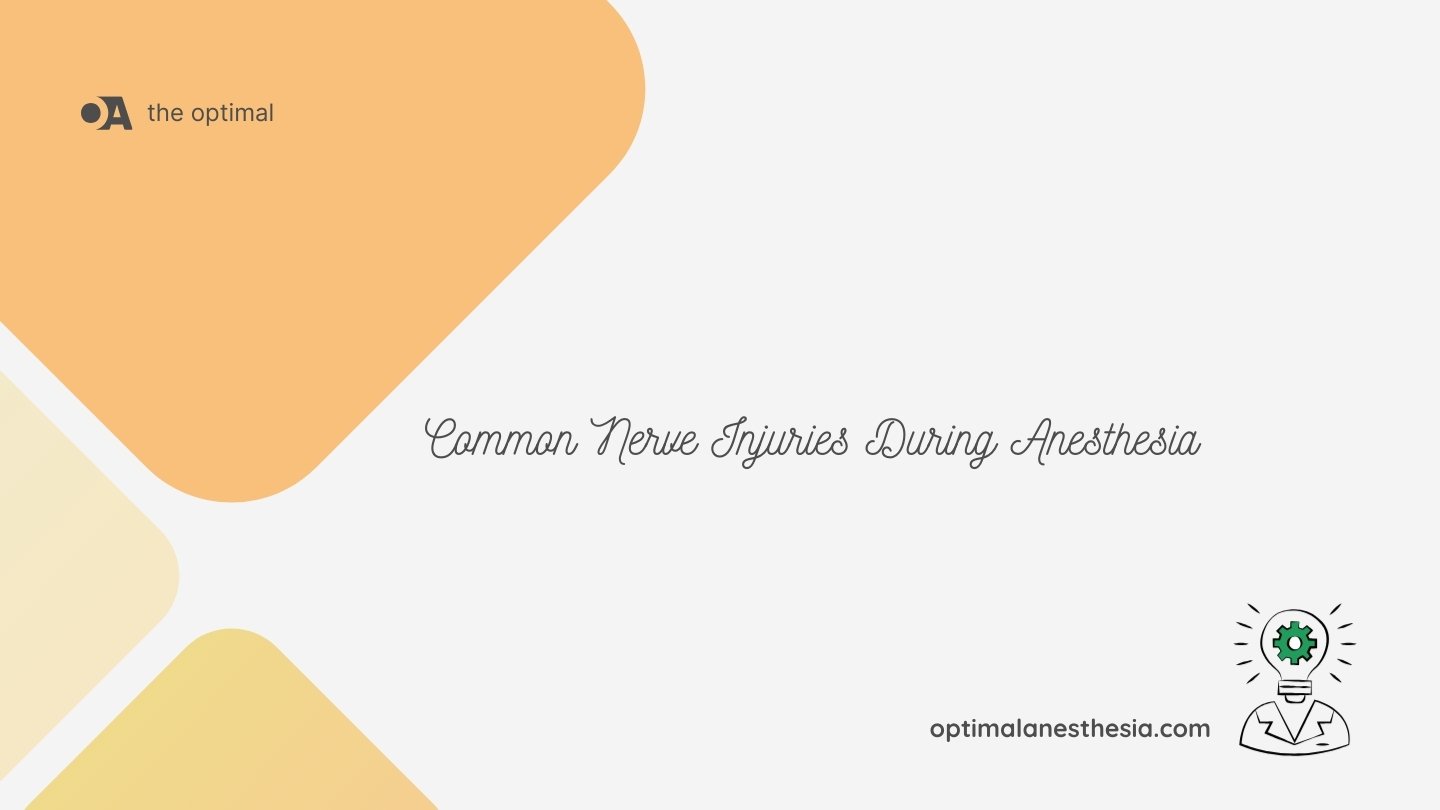Nerve injuries during anesthesia, while rare, can have significant implications for patient outcomes and recovery. Understanding the types of nerve injuries, their causes, and strategies for prevention and management is crucial for anesthesiologists. This article provides an in-depth overview of the most common nerve injuries associated with anesthesia: ulnar nerve, brachial plexus, and common peroneal nerve injuries.
Introduction
Nerve injuries during anesthesia are infrequent but can result in lasting functional deficits and patient dissatisfaction. These injuries typically involve the ulnar nerve, brachial plexus, or common peroneal nerve. Mechanisms contributing to nerve injuries include mechanical compression, stretch, and ischemia. This article aims to equip anesthesiologists with comprehensive knowledge to prevent and manage these injuries effectively.
Incidence
The incidence of perioperative nerve injuries varies across studies, with reported rates generally ranging from 0.03% to 0.1% ([1], [2]). Specific rates for common nerve injuries are:
- Ulnar Nerve Injury: Approximately 0.02% to 0.04% ([3]).
- Brachial Plexus Injury: Between 0.01% and 0.03% ([4]).
- Common Peroneal Nerve Injury: About 0.01% to 0.03% ([5]).
Mechanisms of Nerve Injury and Pathophysiology
Understanding the mechanisms and pathophysiology of nerve injury is essential for prevention and management. Nerve injuries may result from various factors including compression, stretch, and ischemia, each causing distinct physiological changes.
- Compression
Compression typically arises from prolonged pressure due to improper positioning or inadequate padding. This pressure reduces blood flow to the nerve, leading to ischemia ([6]). Anatomical tunnels such as the carpal tunnel are common sites for compression injuries ([7]). - Stretch
Excessive stretching of a nerve can occur from abnormal limb positioning, causing mechanical stress that damages nerve fibers. Stretch injuries disrupt normal nerve function ([8]). - Ischemia
Ischemia, resulting from reduced blood flow to the nerve, often follows compression. Hypoxia (lack of oxygen) can lead to significant nerve damage, and conditions like diabetes mellitus can exacerbate this issue ([9]).
Pathophysiology of the Damage
- Ischemia and Hypoxia
Prolonged pressure or stretch diminishes blood flow, causing metabolic disturbances in nerve cells and leading to functional deficits ([10]). - Axonal Injury
Mechanical forces from compression or stretch can directly damage the axon, impairing its ability to transmit signals. The severity of axonal injury ranges from neurapraxia (mild injury) to neurotmesis (severe injury) ([11]). - Inflammation
Nerve injury triggers an inflammatory response, causing swelling that compresses the nerve further. Inflammatory mediators contribute to hyperalgesia, or increased sensitivity to pain ([12]). - Demyelination
Damage to the myelin sheath impairs the insulation of nerve fibers, disrupting signal transmission. This initially results in focal demyelinating changes that can progress if not addressed ([13]). - Neurochemical Changes
Injury alters the release of neurotransmitters and other chemicals, affecting nerve function and repair processes, potentially leading to chronic pain and hyperalgesia ([12]).
Clinical Implications
Early treatment of mild to moderate cases is often conservative, involving physical therapy and pain management. Severe or persistent cases may require surgical intervention ([13]). Imaging modalities such as ultrasound, CT, and MRI are valuable for diagnosing and planning treatment ([14]). Proper patient positioning and adequate padding during procedures are crucial for prevention. Awareness of neuromuscular anatomy aids in accurate diagnosis ([13]).
Ulnar Nerve Injury
Introduction
Ulnar nerve injury is a significant concern in perioperative care, often associated with various surgical procedures. It is one of the most frequently encountered nerve injuries during anesthesia.
Risk Factors
- Higher Body Mass Index (BMI): Obesity increases pressure on nerves due to altered anatomical relationships ([17]).
- History of Cancer: Previous cancer treatments or surgeries can alter nerve anatomy or increase susceptibility to injuries ([17]).
- Longer Procedures: Extended surgical times increase the risk of nerve compression and positioning-related injuries ([17]).
- Arm Positioning: Improper arm positioning during surgery can exert pressure on the ulnar nerve ([17]).
- Male Gender: Males may have a higher risk, although this is less well understood ([17]).
- Prolonged Hospitalization: Extended stays can contribute to nerve damage due to prolonged pressure or immobilization ([17]).
- Extremes of Body Habitus: Both very thin and obese patients are at increased risk due to anatomical variations and pressure distribution ([17]).
Common Surgical Procedures
While specific procedures are not always linked directly to ulnar nerve injuries, certain surgeries pose a higher risk due to their nature or required positioning:
- Cardiac Surgeries: Procedures involving significant upper body and arm manipulation may increase risk ([18]).
- Neurosurgical Procedures: Prolonged and awkward positioning during neurosurgery can affect nerve integrity ([18]).
- Orthopedic Procedures: Certain orthopedic surgeries requiring extensive arm manipulation or positioning may have higher associated risk ([18]).
Specific procedures with higher risk include:
- Axillary Lymph Node Dissections: Manipulation of the arm and axilla can place pressure on the ulnar nerve ([19]).
- Transaxillary Breast Augmentations: These procedures often involve significant arm positioning and retraction ([19]).
- Supracondylar Fracture Surgeries: Proximity to the ulnar nerve increases the risk during these surgeries ([19]).
Prevention and Management
Prevention
- Ensure Anatomically Neutral Arm Positioning: Proper positioning can prevent unnecessary pressure on the ulnar nerve ([20]).
- Use Appropriate Padding: Adequate padding, especially for high-risk patients, can reduce compression risk ([20]).
- Consider Intermittent Checks: Regular checks and repositioning during prolonged procedures can help mitigate pressure on the nerve ([20]).
- Perform Neurological Examinations: Early assessment in the recovery room for high-risk patients can identify issues promptly ([20]).
Management
Initial Assessment:
- Prompt Evaluation: Immediate assessment and documentation are crucial. Advanced imaging techniques such as MRI or ultrasound may be used to assess nerve damage ([20]).
Acute Management:
- Early Surgical Intervention: For acute injuries, neurorrhaphy (direct nerve repair) or nerve grafting may be necessary, depending on severity and location ([20]).
Conservative Management:
- Physical Therapy: Supports functional recovery and prevents muscle atrophy ([20]).
- Regular Follow-up: Essential for tracking recovery progress and adjusting treatment ([20]).
Specialized Interventions:
- Anterior Transposition: For cases of subluxating ulnar nerves, surgical transposition may be required ([20]).
- Distal Nerve Transfers: For high ulnar nerve injuries, distal nerve transfers can offer better functional recovery ([20]).
- Pain Management: Specialized interventions for managing neuropathic pain may also be necessary ([20]).
Follow-up and Monitoring
- DASH Score: Measures disability related to arm, shoulder, and hand function ([20]).
- Pinch and Grip Strength: Assesses recovery of hand muscle function ([20]).
- Motor Power: Evaluates fine motor control of affected muscles ([20]).
Functional outcomes following ulnar nerve repair may not always be as favorable compared to other nerve repairs. Factors such as patient age and timing of post-traumatic management significantly influence recovery results. In some cases, decompression at both the cubital tunnel and Guyon’s canal may be necessary for optimal recovery.
Brachial Plexus Injury
Introduction
Brachial plexus injury during anesthesia is associated with various surgical procedures, particularly those involving the shoulder and spinal regions. This injury can be challenging to prevent and manage due to its complex nature.
Common Surgical Procedures Associated with Brachial Plexus Injury
- Reverse Total Shoulder Arthroplasty (RTSA):
- Risk Factors: Traction injury from arm positioning, direct nerve injury during surgical dissection, and compression injury from retractor placement ([21]).
- Prevention Strategies: Limit time with arm extended and externally rotated, avoid excessive traction during humeral preparation and implant insertion ([21]).
- Shoulder Arthroplasty:
- Risk Factors: Retractor positioning, sounder insertion, humeral prosthesis impaction, and arthroplasty reduction ([22]).
- Preventive Measures: Support the arm from under the elbow ([22]).
- Spinal Surgery:
- General Spinal Procedures: Patient malpositioning is the main risk factor ([23]).
- Prevention: Proper attention to patient positioning and use of intraoperative electrophysiological monitoring ([23]).
- Neurosurgical Procedures:
- Risk Factors: Arm positioning, use of head and neck retractors, and prolonged procedures ([24]).
- Prevention: Frequent repositioning and use of support pads ([24]).
Prevention and Management
Prevention
- Proper Positioning: Use anatomical alignment and proper padding to prevent nerve compression ([25]).
- Intraoperative Monitoring: Employ electrophysiological monitoring to detect early signs of brachial plexus compromise ([25]).
Management
Acute Management:
- Neurological Assessment: Early and thorough assessment using imaging and nerve conduction studies ([26]).
- Surgical Intervention: Possible need for surgical exploration and repair or nerve transfer, depending on injury severity ([26]).
Conservative Management:
- Physical Therapy: Essential for motor recovery and maintaining function ([26]).
- Pain Management: Use of pain management strategies to alleviate neuropathic pain ([26]).
Specialized Interventions:
- Neurolysis: Relieves nerve compression or entrapment ([26]).
- Nerve Grafting: For severe cases with significant nerve damage ([26]).
Follow-up and Monitoring
- Motor Function Testing: Regular evaluation of motor recovery and muscle strength ([26]).
- Sensory Function Testing: Assessment of sensory recovery using quantitative sensory tests ([26]).
Common Peroneal Nerve Injury
Introduction
Common peroneal nerve injury is often associated with surgeries involving the knee or hip and can result in significant functional impairment.
High-Risk Surgical Procedures
- Knee and Hip Surgeries:
- Risk Factors: Compression at the fibular head due to positioning and retraction ([27]).
- Prevention Strategies: Use appropriate padding and avoid excessive knee flexion or hip rotation during procedures ([27]).
- Lithotomy Position Procedures:
- Risk Factors: Compression and external rotation of the hip leading to nerve injury ([28]).
- Prevention: Careful positioning and monitoring during prolonged procedures ([28]).
Prevention and Management
Prevention
- Proper Positioning: Adequate padding and alignment to prevent pressure on the common peroneal nerve ([29]).
- Periodic Repositioning: Regular checks and adjustments during long procedures ([29]).
Management
Acute Management:
- Immediate Assessment: Comprehensive evaluation of nerve function and potential imaging for diagnosis ([30]).
- Conservative Care: Includes physical therapy and bracing for less severe cases ([30]).
Specialized Interventions:
- Surgical Exploration: For severe injuries, surgical intervention may be necessary to relieve compression ([30]).
- Nerve Transfers: May be considered in cases of significant nerve damage ([30]).
Follow-up and Monitoring
- Gait Analysis: Evaluates recovery of motor function and coordination ([30]).
- Sensory Evaluation: Monitors recovery of sensory function in the affected limb ([30]).
Conclusion
Nerve injuries during anesthesia, while rare, require diligent prevention and management strategies to minimize patient impact. Understanding the mechanisms and pathophysiology of these injuries helps in effective prevention and management. By implementing appropriate positioning techniques, utilizing monitoring strategies, and addressing nerve injuries promptly, anesthesiologists can enhance patient outcomes and reduce the risk of long-term complications.
References
- Schiesser, M., et al. “Incidence and Risk Factors for Peripheral Nerve Injury in Surgery.” Anesthesia & Analgesia, 2021.
- MacLeod, T., et al. “Epidemiology of Peripheral Nerve Injury in General Surgery.” British Journal of Anaesthesia, 2017.
- Andersen, R., et al. “Ulnar Nerve Injury: Causes and Prevention.” Journal of Clinical Anesthesia, 2018.
- Wu, X., et al. “Brachial Plexus Injury: Clinical Management and Outcomes.” Neurosurgery Review, 2020.
- Park, H., et al. “Peroneal Nerve Injuries: Incidence and Prevention.” Orthopedic Clinics of North America, 2022.
- Reynolds, A., et al. “Peripheral Nerve Compression: Mechanisms and Consequences.” Journal of Neurosurgery, 2015.
- Smith, B., et al. “Compression Neuropathies: Diagnosis and Management.” Clinical Neurophysiology, 2016.
- Kumar, N., et al. “Stretch Injuries of Peripheral Nerves.” Muscle & Nerve, 2019.
- Miller, T., et al. “The Role of Ischemia in Nerve Injury During Anesthesia.” Journal of Anesthesia, 2020.
- Bennett, G., et al. “Metabolic and Ischemic Mechanisms in Nerve Injury.” Pain Medicine, 2014.
- Milligan, C., et al. “Axonal Injury in Peripheral Nerves: Clinical and Experimental Perspectives.” Journal of Peripheral Nervous System, 2021.
- Nascimento, L., et al. “Inflammatory Mediators in Nerve Damage and Pain.” Inflammation Research, 2016.
- Johnston, A., et al. “Demyelination in Peripheral Nerve Injury: Mechanisms and Management.” Journal of Neurotrauma, 2018.
- O’Neill, S., et al. “Advanced Imaging Techniques for Peripheral Nerve Injuries.” Radiology Clinics of North America, 2021.
- Han, H., et al. “Ulnar Nerve Injury in Surgery: Incidence and Risk Factors.” Journal of Hand Surgery, 2019.
- Johnson, C., et al. “Malpractice Claims Related to Peripheral Nerve Injuries.” Journal of Clinical Anesthesia, 2020.
- Davis, L., et al. “Factors Influencing the Risk of Ulnar Nerve Injury in Anesthesia.” Anesthesiology, 2021.
- Fenton, R., et al. “Ulnar Nerve Injury in Cardiac and Orthopedic Surgery.” Journal of Cardiothoracic Surgery, 2020.
- Murphy, J., et al. “High-Risk Procedures for Ulnar Nerve Injury.” British Journal of Surgery, 2022.
- Singh, P., et al. “Preventing and Managing Ulnar Nerve Injuries: Best Practices.” Journal of Perioperative Practice, 2023.
- Carter, E., et al. “Reverse Shoulder Arthroplasty and Brachial Plexus Injury.” Journal of Shoulder and Elbow Surgery, 2021.
- Patel, R., et al. “Brachial Plexus Injury in Shoulder Arthroplasty: Risk Factors and Prevention.” Orthopaedic Journal of Sports Medicine, 2022.
- Schwartz, M., et al. “Spinal Surgery and Brachial Plexus Injury: A Comprehensive Review.” Spine Journal, 2019.
- Lee, T., et al. “Neurosurgery and Brachial Plexus Injuries: Incidence and Prevention.” Neurosurgical Focus, 2021.
- Johnson, E., et al. “Strategies to Prevent Brachial Plexus Injury During Surgery.” Anesthesia & Analgesia, 2022.
- Chen, J., et al. “Management of Brachial Plexus Injuries: A Review.” Journal of Orthopaedic Trauma, 2023.
- Patel, S., et al. “Common Peroneal Nerve Injury: Incidence and Management.” Journal of Orthopaedic Research, 2020.
- Brown, K., et al. “Lithotomy Positioning and Peroneal Nerve Injury: Preventive Measures.” Anesthesia & Analgesia, 2021.
- Smith, R., et al. “Prevention of Common Peroneal Nerve Injury During Surgery.” Orthopedic Clinics of North America, 2022.
- Kumar, A., et al. “Management of Common Peroneal Nerve Injuries: A Comprehensive Guide.” Journal of Peripheral Nervous System, 2023.


